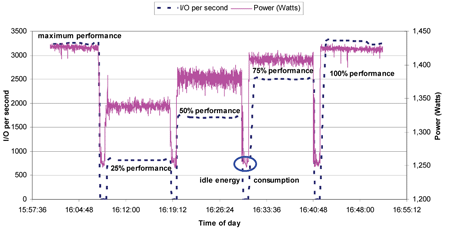by Roger Kahn, Ronen I. Kat and Carlos Pratt
Modern enterprise storage systems have increasing capacity and a need for increased throughput. Currently up to 40 percent of the energy consumption in data centres is associated with storage systems. One IBM research focus is on energy benchmarks that provide insights into the energy consumption of storage systems; specifically, how the workload performed by the user affects energy consumption.
The architecture of a storage server differs from a computing server. In addition to the computing resources (eg processor, memory) found in a computing server, a storage system has internal storage networks and a large number of storage devices, currently disk drives. A large portion of the energy is consumed by these disk drives, primarily by their mechanical spindle motors.
The energy consumption of a storage system may be partitioned into the energy consumption of the storage devices (eg disk drives) and that of the other components of the storage system. Concurrently, the energy consumption can be broken down into energy that is not related to user workload, termed idle energy consumption, and energy that is related to user workload, termed dynamic energy consumption. The total energy consumed by a storage system is the sum of the idle and dynamic energy.
The idle portion of storage system energy consumption is typically 70% to 80% of the maximal storage energy consumption. This is a far higher percentage than the idle energy consumption of a computing server, and is caused by the need to keep disk drives spinning at all times. While some storage systems allow disks to spin down, enterprise systems that rely on providing instant access to data cannot do this. The idle portion of the energy consumption also includes background housekeeping tasks such as media scans, parity checks, etc.
In April 2009, the Storage Networking Industry Association (SNIA) released a first draft for public review of the ‘SNIA Green Storage Power Measurement Technical Specification’. The draft focuses mainly on the idle energy consumption portion of storage systems. In addition, the draft has a comprehensive taxonomy that helps the user to map energy consumption of storage systems based on capabilities and workloads.
The dynamic energy consumption of enterprise storage is directly related to the workload of the storage system. The amount of dynamic energy consumed is a function of the workload and performance of the storage system. As the storage system increases the utilization of the computing resources, network and storage devices, the dynamic energy consumed increases accordingly.
The Storage Performance Council (SPC) recently released the SPC-1C/E benchmark toolkit, which can drive storage systems with up to 48 storage devices, either solid-state drives (SSDs) or disk drives. The SPC-1C/E workload simulates an online transactional processing (OLTP) environment and shows the correlation between performance and energy consumption.
The techniques employed by SNIA and SPC are very similar to those published for servers by the Standard Performance Evaluation Corporation (SPEC). IBM labs have measured the energy consumption and performance of different storage systems for both SNIA and SPC. IBM is using standard energy measurement equipment to measure energy consumption. In addition, energy measurements and performance monitoring are synchronized in order to report the effect of the user workload on energy consumption. The graph in the figure below demonstrates an example workload and energy consumption benchmark for a mid-range enterprise storage system. The benchmark starts by exercising the storage to its highest performance and energy consumption state. This is followed by running workloads that are equivalent to 25%, 50%, 75% and 100% of the maximum performance. For each step, the workload (in I/O per second) and energy consumption are shown. Between benchmark steps, the idle energy consumption is observed. In this case, the idle portion it is approximately 87% of the maximum energy consumption of the storage system.

Figure 1: Energy and performance benchmark for a mid-range enterprise storage system.
For more details on SNIA and SPC benchmarks see the links provided at the end of this article.
The future holds drastic changes for storage systems. The introduction of SSDs will have a significant effect on the energy consumption of storage systems. Also, adding different technologies and techniques such as having ‘dormant’ and ‘active’ drives will further reduce the idle portion of the energy consumption.
The goal of the energy benchmarks in development is to demonstrate a correlation between the user workload and the storage energy consumption and hence help design energy-proportional storage systems. Our work on storage benchmarks began in 2007 and is performed by IBM’s Haifa Research Lab and Tucson performance lab. Future activities include refining models that will aid in the deployment and design of energy-proportional storage systems, and determining how they will affect the bottom line of the customer.
Stay tuned!
Links:
http://www.haifa.ibm.com/projects/storage/pmss/index.shtml
http://www.snia.org/forums/green/
http://www.storageperformance.org
http://www.spec.org/power_ssj2008/
Please contact:
Roger Kahn
IBM Haifa Research Lab
Tel: +972 3768 9527
E-mail:
Ronen I. Kat
IBM Haifa Research Lab
Tel: +972 3768 9493
E-mail:
Carlos Pratt
IBM Tucson Arizona
Tel: +1 520 799 5409
E-mail:










